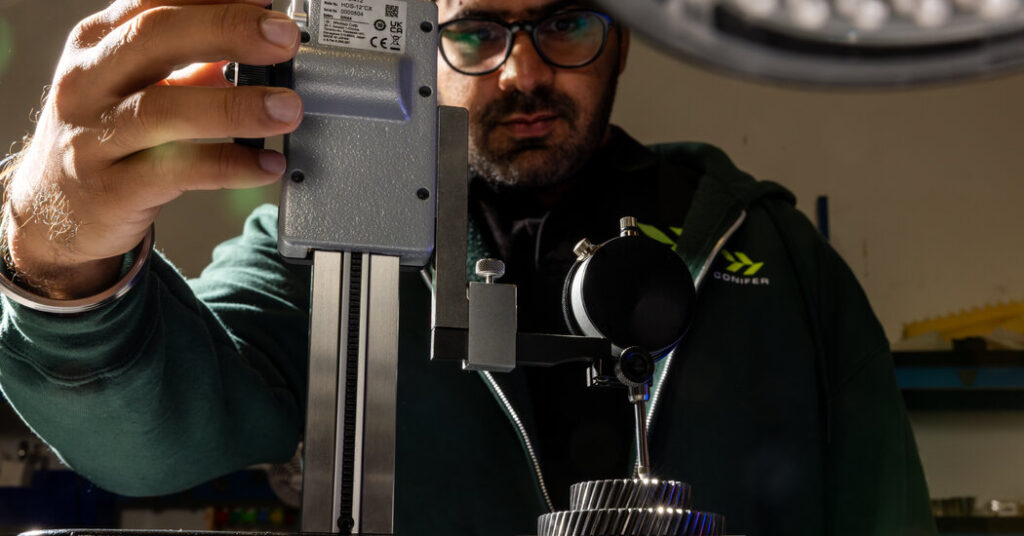Stunned by frequent shortages of essential materials from China, automakers in the United States and Europe are quietly trying to reduce or eliminate the need for materials that have become entangled in superpower rivalries.
The companies are exploring technologies and exotic materials that could replace magnets made with rare-earth metals that are used in dozens of parts in cars and trucks of all kinds. They include components like windshield wiper motors and the mechanisms that allow seats to be adjusted.
Magnets made with the rare-earth elements neodymium, dysprosium and terbium are especially important for the motors that move electric vehicles and hybrids, which are becoming more popular.
China dominates mining and processing of most rare earths and has used its near monopoly as a diplomatic weapon. This year, it imposed controls on exports of some of those materials in apparent retaliation for President Trump’s stiff tariffs on Chinese goods.
The recent instability in rare-earth supplies is a much bigger threat to automakers than in the past. It has given new urgency to the search for motors that don’t need rare earths or for materials that would replace them.
BMW’s electric vehicles already use motors that operate without rare earths. Researchers at Northeastern University and other institutions are working to synthesize materials that have promising magnetic properties and are found only in meteorites.
Start-ups have begun developing new kinds of motors and other technologies. And the Department of Energy is encouraging that work, despite the Trump administration’s rollback of other forms of support for electric vehicles.
Many of these efforts won’t bear fruit for years. And substitute technologies like those used by BMW can be more expensive or have other drawbacks. For the time being, the industry remains extremely vulnerable to shortages that could bring assembly lines to a halt.
“This isn’t a challenge you can overcome in a year,” said Gracelin Baskaran, director of the Critical Minerals Security Program at the Center for Strategic and International Studies in Washington.
This month, Beijing suspended some of its rare-earth export controls as part of an agreement with the Trump administration. But controls remain a threat as tensions between the United States and China continue.
“There is now sort of a détente,” said Tom Moerenhout, who leads the Critical Materials Initiative at Columbia University’s Center on Global Energy Policy. “But the question is not will there be a next event where rare earths are being weaponized, but rather when.”
The auto industry has reckoned with rare-earth shortages before. Beginning in 2010, China choked off supplies, leading to a dispute with the Obama administration.
The coronavirus pandemic, which caused severe shortages of semiconductors and other components, reinforced the dangers of depending too much on a few suppliers or vendors from one country. As a result, many automakers began looking for alternatives.
Carmakers can use two strategies to keep their assembly lines running. They can find rare earths outside China, or they can switch to components that don’t require those metals.
General Motors is pursuing the first strategy with MP Materials, an American company that is mining rare earths in California. MP is also building a facility in Texas to refine the materials and use them to make magnets. Under an agreement announced in 2021, G.M. has promised to buy most of the output of the Texas factory for use in Cadillacs and Chevrolets. MP also has agreements with Apple and the Defense Department.
Such agreements provide companies like MP guaranteed revenue, something that wasn’t available to rare-earth companies and processors that went bankrupt after previous crises when prices fell so much that they couldn’t compete with Chinese suppliers. MP acquired its site in California from one such bankrupt company.
But there is also a risk to automakers like G.M. They may wind up paying more than other manufacturers if shortages ease and prices fall again.
G.M. is also searching for components that don’t need rare earths. “There’s nothing like not having to use rare-earth things, whether it’s magnets or batteries or whatever,” Mark Reuss, the president of G.M., said at a company event in New York recently. “How do we engineer out that dependency?”
A G.M. spokesman declined to provide specifics.
Back in the 1980s, a G.M. unit developed magnets made from neodymium, iron and boron, which are now widely used in electric vehicle motors. But G.M. sold the technology to Chinese companies.
BMW is using motors without neodymium or other rare earths in models like the iX sport utility vehicle. An electric current generates the magnetic field inside the motor that converts electrons to motion.
A spike in the price of neodymium around 2011 prompted BMW to begin developing the technology. The luxury carmaker says it has largely solved the drawbacks of these motors, which tend to be heavier, bulkier and less energy efficient than those with rare earths. The company makes the motors in factories near its headquarters in Munich and in Austria.
The motors are more efficient than those that use rare earths at the speeds required for everyday driving, said Stefan Ortmann, a BMW engineer. There are other advantages, he said. The magnetic field in BMW’s motors can be dialed up or down, and the motors are easier to keep cool.
“We think it’s the sweet spot for us,” Mr. Ortmann said.
A new version of the motor is even more efficient than earlier machines and will be installed in the iX3 S.U.V. that BMW will sell in the United States next summer. The company says that model will be able to travel 400 miles between charges.
Silicon Valley has also taken note of the rare-earth crisis. In rented garages in Sunnyvale, Calif., a start-up called Conifer has developed a compact, disc-shaped electric motor that can operate without rare earths.
Conifer is initially producing motors for two-wheeled vehicles, found by the millions in many countries, but it hopes to produce motors for cars in a few years.
Rare-earth concerns have fueled interest in the technology, said Ankit Somani, a co-founder of Conifer. “Demand is not a problem,” he said. “Our main thing is how do we scale our production quickly.”
But versions of the motors that use rare earths pack more power into a smaller package, Mr. Somani added. The auto industry’s holy grail would be material that matched the advantages of rare earths but did not come from China.
Such materials exist, but only in small quantities around the globe. Tetrataenite, for example, is made of iron and nickel, which are abundant. But it takes hundreds of millions of years for the iron and nickel atoms to form the unique structure of tetrataenite, which occurs naturally only in meteorites.
Laura Lewis, a chemical engineering professor at Northeastern University, and colleagues have developed a way to synthesize tetrataenite in weeks rather than eons. But there is still a long way to go before the material can be mass-produced, she said, and even then it will not replace rare earths in all applications.
“It’s not a short-term solution,” Dr. Lewis said.
The Trump administration is offering grants of up to $3 million to help researchers develop alternatives to rare earths. To qualify, applicants must strive to create magnets twice as powerful as the best rare-earth magnets, a goal that some experts say is unrealistic.
In a document outlining the program, the Department of Energy expressed confidence that the target could be met using artificial intelligence.
“Recent technological advances have the potential to dramatically accelerate new magnet discovery,” the department’s Advanced Research Projects Agency-Energy, said in August. The department did not respond to a request for comment.
Jack Ewing covers the auto industry for The Times, with an emphasis on electric vehicles.
The post An Auto Holy Grail: Motors That Don’t Rely on Chinese Rare Earths appeared first on New York Times.




